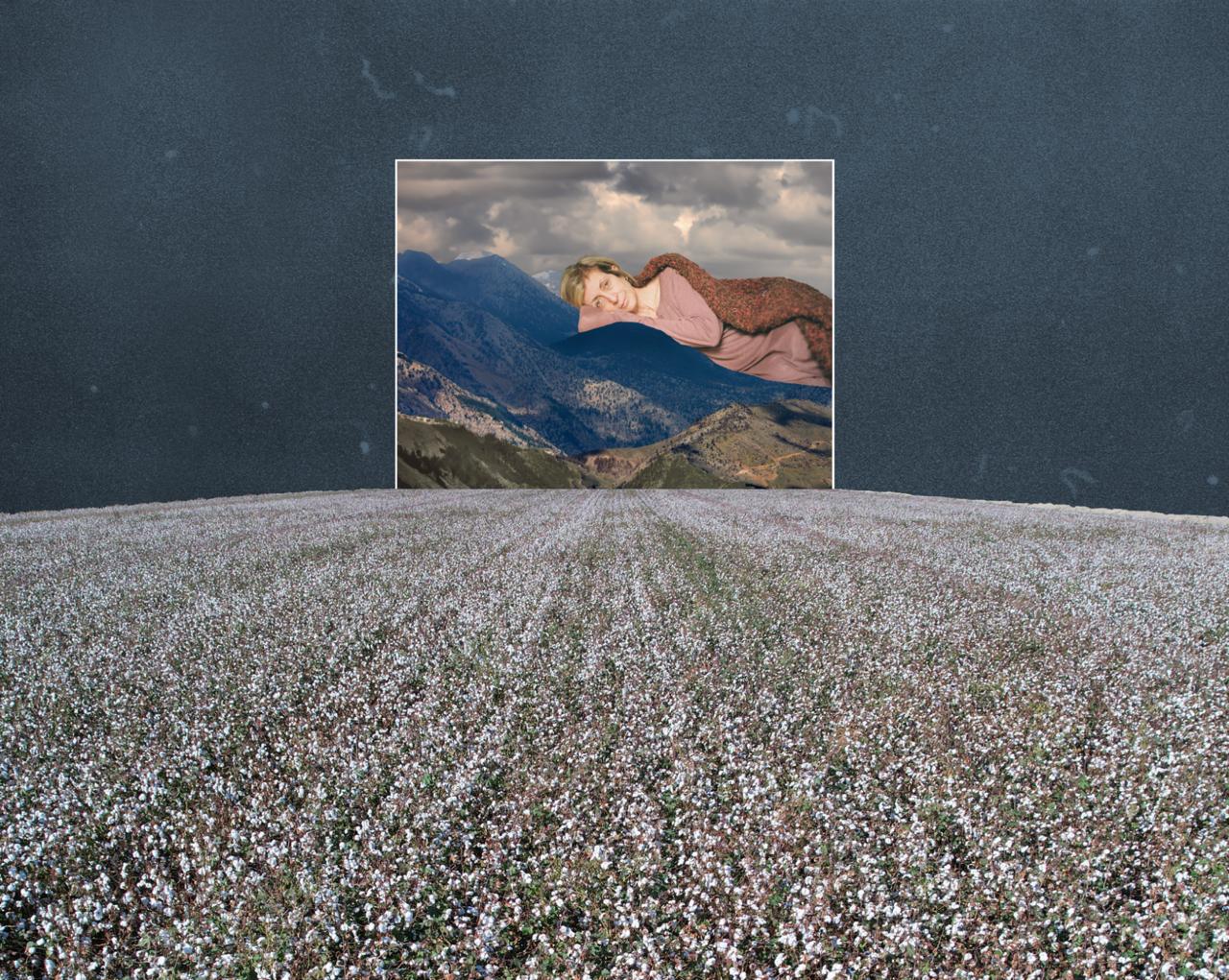Խառնակ Միջոցներ / Mixed Media, 2024
մարմին, հնագոյն
Flesh, Immemorial
«Մարմին, հնագոյն»–ը ստեղծագործական փորձարկութիւն է, որ կը ձգտի հակադարձելու բացակայութեան, եւ խուզարկելու արեւմտահայերու գեղադիտակային մակա(հարկա)դրութիւնը այն տարածքներուն վրայ, ուրկէ անոնք ծագած են։
A creative experiment in the undoing of absence and kaleidoscopic super(im)position of Western Armenians onto their home-landscapes of origin. These mixed-media monuments are radical interventions of place and land from which they descend but may not have access to.

Այս նախագիծին առաջին մասնակիցը Սառա Ապրամզն է, որուն մեծ–մեծ մայրը Էրզրումցի էր։ Մանկութեան տարիներուն, ան առեւանգուած էր քանի մը անգամ, եւ ուրեմն իր ընտանիքը, Քէչապաշեանները, 1905 թուականին փախան իրենց հայրենիքէն՝ սաստկացող սպառնալիքներուն պատճառով։ Այս պատմութեան դժբախտ արձագանգները դեռ կը հնչեն այսօր, Արցախի ներկայ իրավիճակով։
The first participant of this project is Sara Abrams, whose great grandmother was from Erzerum. She was kidnapped as a child several times – and so her family, the Ketchabashians, fled their homeland in 1905 due to increasing threats. Echoes of this story ring too close to home today, through the current situation in Artsakh.
Նախագիծին մասին / About
Flesh, Immemorial is a creative experiment in undoing absence and exploring the kaleidoscopic super(im)position of Western Armenians onto their landscapes of origin.
What began with the poem entitled “Skin” – a love letter and balm for those who felt the echoes of the Armenian Genocide since the war in Artsakh – grew into a constellation of mixed media imprints to generate ancestral healing. It points toward a diasporic futurism and creative reclamation of land, belonging, and autonomy. As a radical intervention in a land from which we descend but may not have access to, I collaborated with participants materially, through archival and current day landscapes, sites, and maps. I collaborated with them through the ethereal, with stories, spirits, flora, and fauna. Such explorations are especially poignant for those who continue to survive displacement and live with intergenerational trauma.
Participants:
Ali Cat Chavez (Bitlis)
Emily Mkrtichian (Van)
Milena Abrahamyan (Lori)
Sara Abrams (Erzrum)
Satenig Mirzoyan (Palu)
Emma Basmadjian (Adana)
Patil Halajian (Marash)
Saana Araxi Abrahamian-Hoyt (Dikranagerd & Sis)
Այս նախագիծը սկիզբ առաւ «Մորթ» քերթուածով՝ սիրոյ նամակ մը եւ սպեղանի մը անոնց համար, որոնք Մեծ Եղեռնին արձագանգները կը լսէին 2020-ի Արցախեան պատերազմէն ի վեր – , եւ աճեցաւ դառնալու բազմագիտակարգային տպագրութիւններու համսատեղծութիւն մը՝ նախնիներու/բնիկի միջոցով բուժում յառաջացնելու։ Ան կ’ուղղուի դէպի սփիւռքեան ապագայապաշտութիւն եւ հողի, պատկանելիութեան ու ինքնավարութեան արմատական վերստանձնում։ Փափաքելով արմատային միջամտութիւն մը բերել այն հողերուն, որոնցմէ սեռած ենք բայց որոնց թերեւս չենք կրնար մատչիլ, համագործակցեցայ մասնակիցներու հետ նիւթական մակարդակի, այսինքն արխիւային եւ ժամանակակից բնապատկերներու, տարածքներու ու քարտէզներու միջոցով։ Համագործակցեցայ անոնց հետ եթերայինին միջոցով՝ պատմութիւններով, ոգիներով, տեղական բուսականութեամբ եւ բնիկ կենդանազգիներով։ Այսպիսի խուզարկումներ յատկապէս յուզիչ եւ կարեւոր են անոնց համար, որոնք կը շարունակեն տեղահանութիւն վերապրիլ եւ միջ–սերունդային խոցեր կրել։
Մասնակիցները.
Ալի Քաթ Շաւէզ (Պիթլիս)
Էմիլի Մկրտչեան (Վան)
Միլենա Աբրահամեան (Լոռի)
Սառա Ապրամզ (Էրզրում)
Սաթենիկ Մրզոյեան (Բալու)
Էմմա Պասմատճեան (Ատանա)
Փաթիլ Հալաճեան (Մարաշ)
Սանա Արաքսի Աբրահամեան-Հոյթ (Տիկրանակերտ եւ Սիս)
Մորթ
Որո՞ւ մարմինն է ասիկա եթէ ոչ ինծի տուածը
Որո՞ւ մորթին մէջ եմ
անծանօթ ինծի
Ախ
Անցումի մէջ եմ
Այն ծալքէն, որ կայ «տուն» կոչածիս եւ մայրենի հողին միջեւ
Սա հողերը
Իմ միսիս, կ’ընդդիմանան արեւմուտք մայր մտնող արեւի համբոյրին եւ ոչ ուրիշին
Ուրիշ եմ
Միշտին մէկ կողմը եւ միւսը
Ոչ ամբողջ, ոչ ալ գոհացած՝ մինչեւ որ միակ հետեւած շարժումս հովունն ըլլայ
եւ գետերունը
որոնք ժառանգութեանս տեսավայրին ձեւ կու տան
Ըսել կ’ուզեմ մորթը
Մարմինները մեր ազգատոհմերուն
Լի են ժամանակին ընդմէջէն մեր գրգռած կրակով
Այդ մէկ ժամանակը
Գիտցանք որ յաւիտեան էր
Եւ որ մենք ենք
Բացայայտօրէն
Յուշէն անդին
Skin
Whose body is this if not one I was given
Whose skin am I in
unfamiliar to me
Ahh
I am in transit
In the fold between the house I call home and the home-land
These lands
Of my flesh they resist the kiss of a sun that sets in the west and no other
I am other
On either side of always
Neither whole nor satisfied until the only movement I follow is of the wind
and the rivers
that shape the landscape of my inheritance
I mean the skin
The bodies of our kin
Are abound with the fire that we have tended through time
That one time
We knew that it was forever
And that we
Are unequivocally
Immemorial
Փաթիլը՝ ազգականներուն հետ խորհրդակցելէն ետք, իր նախահայրական պատմութիւնը փոխանցեց ինծի եւ արտօնութիւն տուաւ որ հանրային բեմով կիսուի։ Մեծ Եղեռնի ատեն, անապատէն անցնելու ընթացքին, իր մեծ հայրը բաժանուած էր ընտանիքէն, եւ ի վերջոյ որդեգրուած էր սուրիացի մահմետական ընտանիքի մը կողմէն, որուն հետ ան ապրեցաւ եօթ տարի։ Հետագային ան առեւտրականէ մը լսեց, որ իր եղբայրն ու ընտանիքը Հալէպ էին, եւ անոնք վերամիաւորուեցան։
After speaking with her family members, Patil passed on her ancestral story to me and gave me permission to share publicly as well. During the genocide, her grandfather was separated from his family while crossing the desert and ended up being taken in by a Syrian Muslim family, whom he lived with for seven years. Eventually, he heard from a merchant that his brother and family were in Haleb and they reunited.
Follow Kamee Abrahamian on Instagram for updates and email them at lorikamee (at) gmail (dot) com if you’re interested in hosting this project.
Այս նախագիծը աջակցութիւն ստացաւ «Գալուստ Կիւլպէնկեան» Հիմնարկութենէն՝ արդ եւ|in view արեւմտահայ մշակոյթի նպաստին պարունակին մէջ։ Յատուկ շնորհակալութիւն մը Ալեքսիա Հաթունին՝ իմ արեւմտահայ քոյրիկս եւ հայ–ապագայապաշտութեան մէջ շարունակուող համագործակիցս/երազակիցս ըլլալու համար։
Special thanks to the Gulbenkian Foundation for their generous support of this project, within the framework of the արդ եւ|in view Western Armenian cultural grant program.










